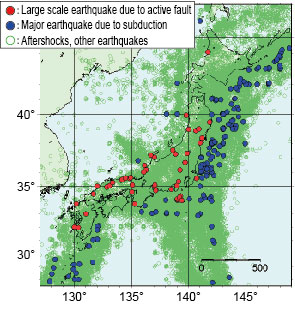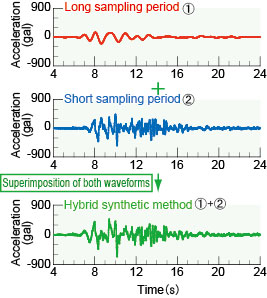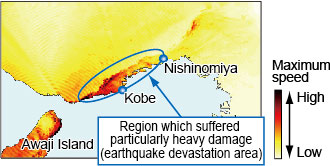4.Prediction method of earthquake clusters including main shocks and aftershocks
- A method has been developed to estimate the timing and size of aftershocks following a major earthquake.
- A method has been developed to predict seismic motions over a wide periodic range and widespread areas including a main shock and the following aftershocks.
In the 2011 off the Pacific coast of Tohoku Earthquake, large-scale aftershocks, which occurred after a major earthquake with a large amplitude and long duration, caused damage to various facilities. Therefore, when the safety of railway facilities against large earthquake, it is crucial to consider aftershocks, which are expected to be occurred after a main shock, in addition to accurately estimating seismic motions of the main shock itself.
In this study, approximately 1.8 million data of past earthquakes (Fig.1) was statistically processed to build a model for accurately estimating not only the timing but also the scale of aftershocks following a main shock.The model revealed that relatively large-scale aftershocks (the difference in magnitude between aftershocks and a main shock is about -1.0) are expected to be occurred within a few hours after a main shock of active fault earthquakes and large-scale aftershocks eventually occur about three times.
In addition to the above, a system for estimating seismic motions over a wide periodic range and widespread areas has been developed based on a hybrid synthetic method in order to accurately predict seismic motions of main shocks and aftershocks (Fig.2). The method is achieved by superimposing the results obtained by the following two processes; 1) long-period components are calculated by using the voxel FEM in order to achieve a high-speed calculation considering the complex shape of widespread areas, 2) short-period components are calculated by a modified stchastic Green’s function method in order to easily incorporate the characteristics of seismic motions at each time.
By combining the outcomes of the above, it has become possible to predict the time series of earthquake clusters including main shocks and aftershocks. The applicability of the prediction method is validated by ensuring that seismic motions during 1995 Hyogo-ken Nanbu earthquake are well reproduced by the method (Fig.3).

Fig.1 Hypocenter distribution used for evaluating aftershocks
Fig.2 Seismic motion prediction using the developed method

Fig.3 Results of evaluation of 1955 Hyogo-ken Nanbu earthquake